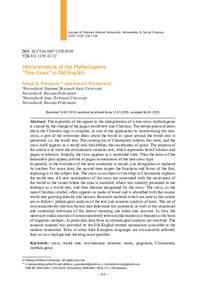Interpretations of the Mythologeme “Tree-Cross” in Old English
Скачать файл:
URI (для ссылок/цитирований):
https://elib.sfu-kras.ru/handle/2311/135165Автор:
Proskurin, Sergei G.
Proskurina, Anna V.
Проскурин, С.Г.
Проскурина, А.В.
Дата:
2020-03Журнал:
Журнал Сибирского федерального университета. Гуманитарные науки. Journal of Siberian Federal University. Humanities & Social Sciences;2020 13 (3)Аннотация:
The topicality of the appeal to the interpretation of a tree-cross mythologeme is caused by the change of the pagan worldview into Christian. The development of ideas about the Christian sign is complex, in one of the approaches to transforming the tree-cross, a part of the overcome ideas about the world as space around the world axis is preserved, i.e. the world tree. The coming era of Christianity inherits this view, and the cross itself appears as a world axis that defines the coordinates of space. The purpose of the article is to show the evolutionary semiotic row, which represents both Christian and pagan symbolism. Initially, the cross appears as a motivated view. Then the terms of the denotative plan appear, devoid of pagan connotations of the tree-cross type.
In general, in the evolution of the term continuity is traced, one designation is replaced by another. For some time, the second item copies the functions and forms of the first, replacing it in the subject line. The cross as an object of worship in Christianity replaces the world tree. All new nominations of the cross are associated with the motivation of the world as the center where the altar is installed, which was initially presented in the tradition as a world tree, and then became designated by the cross. The cross, as the main Christian symbol, often appears as made of wood and is identified with the cosmic world tree growing directly into heaven. Research methods which are used in this article are as follows: philological analysis of the text and semiotic analysis of texts. The set of communicatively relevant factors that determine the statement, as well as the situational and contextual relevance of the lexical meaning, are taken into account. In turn, the necessary initial amount of communicatively relevant information is obtained on the basis of linguistic methods. In particular, data from an etymological analysis are involved. The research material was provided by the Old English written monuments accessible to the modern researcher. Texts in other Indo-European languages are occasionally referred; they act as a background showing some parallels Актуальность обращения к интерпретации мифологемы «дерево-
крест» вызвано переломным характером эпохи смены языческого мировоззрения
христианским. Развитие представлений о христианском знаке носит сложный
характер, в одном из подходов в преобразовании дерево-крест сохраняется часть
преодоленных знаний о мире как пространстве вокруг мировой оси, т.е. мировом
древе. Наступившая эпоха христианства наследует это знание, а сам крест
предстает мировой осью, определяющей координаты пространства. Цель статьи –
показать эволюционный семиотический ряд, который представляет христианско-
языческую символику. Изначально крест возникает как мотивированный образ.
Затем появляются термины денотативного плана, лишенные языческих коннотаций
типа cross.
В целом, в эволюции термина прослеживается преемственность, одно обозначение
заменяется другим. В течение некоторого времени второй предмет копирует
функции и формы первого, замещая его в предметном ряду. Крест как предмет
поклонения в христианстве замещает мировое дерево. Все новые номинации
креста связываются с мотивированностью мира как центра, где установлен алтарь,
который изначально представлялся в традиции мировым деревом, а затем стал
обозначаться крестом. Крест как главный христианский символ часто предстает
как сделанный из дерева и идентифицируется с космическим мировым древом,
растущим прямо в небеса. Методы исследования – филологический анализ текста и
семиотический подход к анализу текстов. Во внимание принимается совокупность
коммуникативно-релевантных факторов, обуславливающих высказывание, а
также ситуативная и контекстная отнесенность лексического значения. В свою
очередь, необходимый исходный объем коммуникативно-релевантной информации
получен на основе лингвистических методов. В частности, привлекаются данные
этимологического анализа. Материалом исследования послужили доступные
современному исследователю древнеанглийские письменные памятники. Тексты
на других индоевропейских языках привлекаются эпизодически, они выступают в
качестве фона, демонстрирующего некоторые параллели

